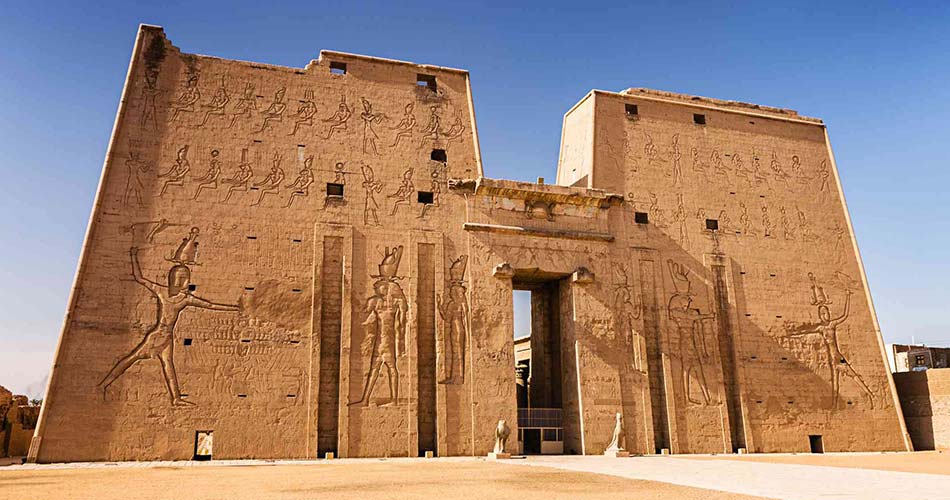The Horus Temple, also known as the Temple of Horus at Edfu, is one of the best-preserved ancient Egyptian temples and is dedicated to the god Horus.
Horus Temple Located in the city of Edfu, about 60 km south of Luxor.
It was built during the Ptolemaic period between 237 and 57 BC. The temple was constructed on top of an earlier temple from the New Kingdom period, which had fallen into disrepair. The construction of the new temple took almost 200 years to complete, with multiple pharaohs contributing to its design and decoration.
The Horus Temple is an excellent example of the traditional Egyptian temple design, with its entrance pylon, courtyard, hypostyle hall, inner sanctuary, and various chambers. The entrance pylon is decorated with carvings depicting the pharaohs making offerings to the gods, while the hypostyle hall features 32 pillars, each adorned with intricate carvings of gods, pharaohs, and mythical creatures. The inner sanctuary, which was only accessible to the high priests, houses a statue of Horus standing on a pedestal.
One of the most impressive features of the Horus Temple is its extensive decoration, which covers almost every surface of the temple. The carvings and reliefs depict scenes from Egyptian mythology, including the battles between Horus and his uncle Set, as well as scenes of daily life, such as farming and fishing. The intricate hieroglyphs and paintings are not only beautiful but also provide valuable insight into the religion and beliefs of the ancient Egyptians.
The temple was rediscovered in the 19th century by French archaeologist Auguste Mariette, who found it buried under sand and debris. It has since undergone extensive restoration work, including the removal of centuries of accumulated dirt and grime, as well as the reconstruction of damaged sections. Today, visitors can explore the temple and its many chambers, admiring the intricate carvings and reliefs that adorn its walls.
In addition to its historical and cultural significance, the Horus Temple is also an important site for understanding the development of ancient Egyptian architecture. Its design and decoration have influenced many other temples built during the Ptolemaic period and beyond. The temple is a testament to the skill and artistry of the ancient Egyptian craftsmen, who created a structure that has stood the test of time and continues to inspire awe and wonder to this day.
The Horus Temple is not just a testament to the artistry and skill of ancient Egyptian craftsmen, but also a reflection of the religious beliefs and practices of the time. The temple was built to honor the god Horus, who was revered as a symbol of kingship and protection. According to Egyptian mythology, Horus was the son of Osiris and Isis, and he was believed to have defeated his uncle Set in a great battle, thus becoming the king of Egypt.
The temple’s construction was closely tied to the religious and political aspirations of the Ptolemaic dynasty, who sought to legitimize their rule by aligning themselves with the ancient Egyptian gods and traditions. The temple’s decoration and design reflect this, with many scenes depicting the pharaohs making offerings to the gods and participating in religious rituals.
The Horus Temple’s importance extends beyond its religious and cultural significance. It has also played a role in the study of ancient Egyptian history and archaeology. The temple’s inscriptions and decorations have provided valuable insights into the language, art, and mythology of ancient Egypt. The discovery of the temple and its subsequent restoration have also shed light on the techniques and tools used by Egyptian craftsmen, as well as the challenges faced by archaeologists and preservationists in their efforts to protect and conserve such ancient treasures.
The temple’s location also adds to its allure. Edfu, the city in which the temple is located, was an important religious and cultural center in ancient Egypt, and the temple was one of several that were built in the area. The city’s strategic location on the Nile River also made it an important trading hub, connecting Upper and Lower Egypt. Visitors to the Horus Temple can experience not only the grandeur of the temple itself but also the rich history and culture of the surrounding region.
Overall, the Horus Temple is a remarkable testament to the ancient Egyptian civilization and its enduring legacy. Its impressive architecture, intricate decoration, and cultural significance continue to fascinate and inspire people from all over the world.



